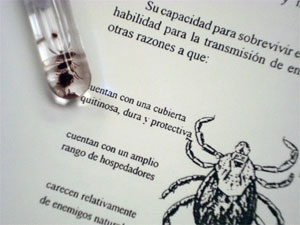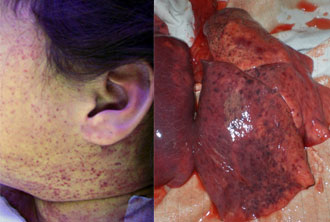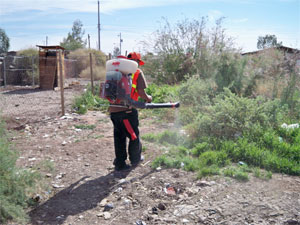NCIS Atlanta: Severe Rash Illness in Baja
Posted March 18, 2009 by Ali S. Khan

Specimen captured in the Sanorales Region by Biologist Beatriz Salceda of the Entomology Department of the Institute of Epidemiological Diagnosis and Reference of the Ministry of Health, Mexico. Photo courtesy of Dr. Rocío Sánchez, Medical Epidemiologist of the Directorate General of Epidemiology (DGE), leader of the outbreak invetsigation team.
A mysterious cluster of illnesses and deaths of unknown cause was recently reported in Baja California, a Mexican state that – as the Spanish translation suggests – is situated just below the California-Mexico border. Our shared border with Mexico fosters a mutual interest in epidemiologic events like this one -- where time is of the essence and lives are at stake.
On February 19, Mexican Federal health authorities were contacted by Baja California State Health Services with news of 8 deaths occurring between September 4, 2008 and February 19, 2009. A team of medical epidemiologists in Mexico immediately began unraveling the initial details of the outbreak and recognized that the disease mainly affected children. Infected individuals had a fever, rash, and problems in many of their organs - symptoms that resemble a number of illnesses common to lower latitude areas, like dengue or malaria. Panels of tests were run by the Baja California State Public Health Laboratory (Isesalud) and the National Public Health Laboratory (InDRE). Results for measles, rubella, parvovirus, Epstein-Barr virus, Leptospirosis, dengue and West Nile Virus were all negative – as were bacterial cultures. The investigative team then suspected Rickettsia disease and reached out to CDC to confirm their suspicions.

LEFT:Petechial rash caused by RMSF. RIGHT:Pulmonary hemorrhage observed during autopsy. Photos courtesy of Dr. Tupak Pérez Medina and Dra. Ma. Elena Marín Fragoso, Medical Pathologists of Mexicali’s General Hospital.
A joint CDC-Mexico call was held on February 25, brokered by our colleague Dr. Steve Waterman in the Division of Global Migration and Quarantine, who run an innovative cross-border infectious disease surveillance system, to engage CDC’s unexplained death and severe illness strike team. Blood samples arrived at CDC in Atlanta on February 27 and later that evening Dr. William Nicholson – a Rickettsia microbiologist – broadcast via email that serology results were consistent with infection with Rickettsia rickettsii, a bacteria spread by ticks that causes a disease called Rocky Mountain Spotted Fever. Shortly thereafter, Dr. Marina Eremeeva reported that two of the samples were PCR positive. By the next morning, they had genetic sequence data that showed that the agent was definitely R.rickettsii. This specific identification of the disease allowed our Mexican colleagues to target their treatment and prevention strategy, even as tissue and serum samples of suspect cases continue to be analyzed.

Fumigation activites in the houses of the Santorales Region with support from voluntary personnel from the Center of Rehabilitation and Counseling for Drug and Alcohol Addiction (CREDA). Photo courtesy of Dr. Donald McBeath, medical veterinarian from the Vectorborne Diseases Action Program Department of the General Directorate of Preventive Action Programs of the National Center of Epidemiological Surveillance and Disease Control (CENAVECE), Ministry of Health, Mexico.
Communication and collaboration with our Mexican colleagues was critical for identifying this disease as they now continue their investigation and implement control measures to address the ecology of this disease. Special thanks to Dr. Hugo López-Gatell Ramírez, Director General of Epidemiology, Mexico Secretariat of Health, for this collaboration. Once they had a working diagnosis, they were able to document the presence of large numbers of brown dog ticks (Rhipicephalus sanguineus) in the areas where cases were occurring. Conditions facilitating this outbreak include large number of stray dogs, illegal landfills, and environmental conditions that allow ticks to proliferate. Epidemiologic and environmental field activities are underway in Mexico to decrease stray dog populations and treat the affected environment for ticks. Education of residents and healthcare workers is also being undertaken as a vital step to contain this outbreak. Stay tuned to hear more as we collaborate with our international neighbors to tackle disease.
Comments
No comments posted.
Disclaimer: The content of Public Health Matters expresses the opinions of its authors and does not necessarily represent the views of the Centers for Disease Control and Prevention.
- Page last reviewed: March 18, 2009
- Page last updated: March 18, 2009
- Content source: National Center for Zoonotic, Vector-Borne, and Enteric Diseases
Get email updates
To receive email updates about this page, enter your email address:
Contact Us:
- Centers for Disease Control and Prevention
1600 Clifton Rd
Atlanta, GA 30333 - 800-CDC-INFO
(800-232-4636)
TTY: (888) 232-6348
24 Hours/Every Day - cdcinfo@cdc.gov


